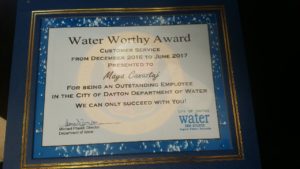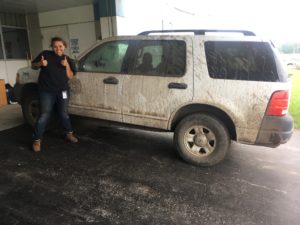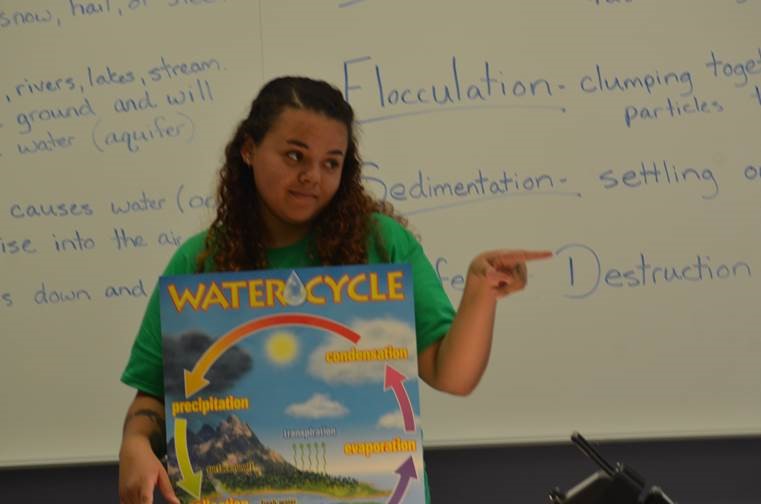Trying to become Willy the Waterdrop: Maya Canaztuj ’17 at Dayton’s Water Supply and Treatment Division in Dayton, Ohio
Oct 27, 2017It’s six in the morning and your alarm is going off. You reach past the glass of water you sat on your night stand last night and stop the assaulting noise. You begrudgingly drag yourself out of the bed and go to use the restroom. You wash your face, wash your hands, and brush your teeth. The bath rug feels damp under your feet from your shower last night. You walk into the kitchen and turn on the tap to fill up the coffee machine. The smell of roasting beans helps you to wake up and start your day.
Water is such an integral part of everyone’s day, you turn on your faucet and water comes out. How does that water get there? Where is it coming from? What gets done to it to make it safe to drink? These are questions that not many people consider on a regular basis because water seems to be so plentiful and is considered a reliable source. As an intern at the City of Dayton, Water department Division of Water Supply and Treatment, I was able to get a firsthand look at the water treatment process from aquifer to homes.
I started working for WST in the early months of 2016. My only experience had been field positions that included plant identifications and getting dirty. I had no laboratory experience outside of my two quarters of chemistry class. I walked in unsure of my abilities to understand the scientific jargon that these Water- bacteriologists Chemists were spewing from their lips. I had to be slowly walked through all the processes, the methods, the rules as I scrambled to take legible notes in the journal I had purchased weeks in advance. At the end of my first week, as the day was winding down and the labsters were talking about their lives outside of the lab, I thought about how lucky I was to have gotten this opportunity. It had been chance that I had free time when Kim Landsbergen emailed me asking if I was available to meet some people from the water department. I was introduced to Keshia Kinney and Mike Rosselet. At the time Keshia was the Laboratory Technical Supervisor and now she is the Acting Division Manager, once I saw what they could do, I knew I wanted to work with them.
As I became more confident as an intern, I asked to take on more tasks. I wanted to know the inner workings of the water world. I asked about new instruments and invited myself to places and eventually my boss realized that I was craving to take on more work. So he assigned me a project. The EPA released a rule that all surface water treatment plants would now need to monitor for microcystin in their raw water. Dayton is ground water un der the influence of surface water, what this means is we pull water from the aquifer and in order to prevent it from going dry, we recharge with river water. My boss decided it would be interesting to see if their were any trace of microcystin in the recharge ponds which is a step before the wa
der the influence of surface water, what this means is we pull water from the aquifer and in order to prevent it from going dry, we recharge with river water. My boss decided it would be interesting to see if their were any trace of microcystin in the recharge ponds which is a step before the wa ter gets returned to the ground. I spent all summer creating and executing a project that was designed to expand my knowledge on how to collect and run test on potable and non potable water. This was made easy when I was asked to step into a field position that was open due to someone leaving, although it was only temporary, I was given the confidence and freedom to make changes at the lab and to explore that city I got to work in.
ter gets returned to the ground. I spent all summer creating and executing a project that was designed to expand my knowledge on how to collect and run test on potable and non potable water. This was made easy when I was asked to step into a field position that was open due to someone leaving, although it was only temporary, I was given the confidence and freedom to make changes at the lab and to explore that city I got to work in.
At the end of the study my data showed that there was no evidence of there being any microcystin in the recharge pools which proved for a boring data graph but I learned an enormous amount of new skills. This job has changed my life. I originally thought I would be working in a parks system that allowed me to be outside and talking about plants. Now that I have laboratory experience I can expand my post undergrad job search that includes both topics that I now love. I look forward to continuing my development in environmentally friendly ideas, water protection area safe practices and customer service skills for when everyday people have questions about where their water comes from. I highly recommend that people in the environmental science field get internships that allow them to experience the different aspects of all possible future opportunities.



